Bespoke
Frequently Asked Questions
Buying a product ‘off the shelf’ is usually a straight forward process, however commissioning something bespoke raises a whole a whole series of questions for clients. Therefore I have attempted to address this below with questions I have been asked over the years. If you come to the bottom off the list and still have queries then by all means get in touch.
Is bespoke the same as made to order?

As the majority of my work is made to order and most of my designs allow for some customisation, then technically, requesting a specific RAL paint colour for Vitulus (by way of example) makes it bespoke. However when I refer to bespoke, it has more to do with a collaboration with a client in terms of deciding on an overall design.
What type of bespoke work do you take on?
I am interested in making both functional pieces as well as solely decorative, however if you are looking for something purely functional and cost is your only concern (eg a painted MDF cupboard for your electricity meter) then I wouldn’t be the right person for you. If however the idea of something that has a strong leaning towards the worlds of Art or Design from an aesthetic perspective makes your heart sing, then please read on.
Can you reproduce a piece that I have seen online / in a shop in a different size or materials?
Whilst I welcome the idea of clients showing me images of work that they like in order to help me understand their tastes, I need to have a certain degree of aesthetic input so that I don’t feel I am plagiarising.
I have designed my own piece, will you make it for me?
It sounds like you may be looking for someone who is purely a maker rather than a designer-maker or artist. However, I have worked with interior designers and architects who already have a very clear direction that they wish to steer a project in and who are keen to combine two creative minds.
Why do your clients choose to commission a bespoke piece from you?
This would be probably be best answered by my clients and if you scroll beyond the case study below you will find some testimonials. However if I were to sum this all up I’d say that the combination of my passion, creative flair, technical knowledge, attention to detail and precise craftsmanship is what clients are drawn to. I think it is important to be a good listener so that my clients feel things are going in the right direction. However I’m not afraid to express an opinion or flag up potential issues when a client’s choices may not be in their best interest.
Do the pieces in your portfolio represent everything that you do?
My current portfolio highlights the work I am most proud of in terms of my creative input. As I am naturally drawn to working with curves then this is reflected. Some of the more minimalist, recti-linear commissions have therefore been omitted.
Hardwood, resin and bronze are the materials I turn to first, however by working with highly skilled partners there are many more options available to me. If you are interested in materials or finishes not found on my website then please feel free to ask. I relish the opportunity to move my ideas in new, unanticipated directions, based on the request of a client.

How will I know what the piece will look like before it is made?
I use various ways of illustrating what the final idea will look like and these depend mostly on how complex the idea is to visualise. A simple minimalist idea can be represented with a 2D line drawing (showing front, side and top views). If the form is more sculptural then this calls for a 3D representation. This can be a scale model, a perspective drawing or most commonly a 3D computer render. The latter allows you to see the piece from a variety of angles.

How accurate are your computer renders?
I produce my own renders which I believe give clients are very good idea of what to expect. I can also commission photo realistic drawings should you wish to take the visualisation to the next level. Please note that particularly when working with natural materials like wood or replicating patinas on the surface of a metal, the render will be using a sample texture and could never replicate the eventual material or finish.
Can I make changes to your initial concept drawings?
Whilst our initial conversation should provide me with enough information so that the concepts I create are well on their way to the final version, it is very common that some tweaks will need to be made.
Do you charge a design fee?
Yes and the amount varies depending on what on the type of project you are interested in. Following our initial conversation I will have a better idea of the time required to both generate new concepts and to visualise them and will quote you a fee accordingly. Usually this is an upfront fee before the making process begins.
How much does your work cost?
As each project is very different then the answer is How long is a piece of string? However after our initial conversation I will be able to give you a ballpark figure. The complexity of the design and making processes will determine this to a large extent. For example curved surfaces are much more laborious to create than flat ones.
At what point in the process do your clients need to commit to making a payment?
Usually, the client commits first to the design fee and then to the making costs (50% up front). Occasionally both costs are rolled into one when starting with a clear vision of the final piece. The final 50% will be due on completion.
Where does my inspiration come from?
I am particularly fascinated by themes of movement and flow; this could be derived from ripples in water or equally from the spiral motion of a meteorological or celestial phenomenon. However inspiration is simply everywhere; the elegance of a ballerina’s pose, the bodywork of a vintage Ferrari, the visual distortions in an Op Art painting – the list is endless.

If a client doesn’t consider themselves to be creative, does that matter?
Not at all. In these cases, my existing portfolio usually acts as the starting point for our conversation and I usually ask for some visual references as to the sort of things you like. These may be objects you already own or could be more related to an interest of yours. Perhaps, like me, you are drawn a theme that I am inspired by (see previous question). Ultimately it is my responsibility to ask the right questions to allow me to do the creative part.
Can I see the piece being made?
I keep clients updated with photos and sometimes videos of the making process. Clients who live locally are also welcome to visit the workshop (by appointment).
Do you offer a consultation at our premises?
Following an initial phone call / video call to understand your project and ascertain your needs we will already have a sense of whether we might work together. I offer an on-site consultation (free in the Manchester area) so that I can have a better understanding of the environment the piece would be going in as well as understanding you and your tastes. This can also be done by video should you prefer.
Can I see a sample of the material?
I have an extensive collection of wood samples and also in other materials in the workshop, so if you are unsure of what to expect, then please ask.

Water Mill Gardens Sculpture – commissioning case study
Initial Contact
I was first approached about this project back in November of 2021 after Cube Homes, a Manchester based property developer, had seen my illuminated sculpture, Transmission (pictured below).

The land for one of their developments (Watermill Gardens) had originally housed a watermill dating back to the 1500s and they wanted to mark the site’s history with a sculpture created by a local artist. The watery theme and circular flow in Transmission had sparked their imagination and they enquired whether I’d be interested in tendering for the job. After seeing the housing development’s graphic logo (an abstraction of a waterwheel with leaves in the place of paddles) I immediately pictured where this project could go and that it wouldn’t be a case of generating a completely new concept. Whilst Transmission took the idea of ripples emerging from a circular form and then dissipating towards the edge of the dish, the obvious solution was that the waterwheel, would create the ripples from its 8 paddles.
Estimate
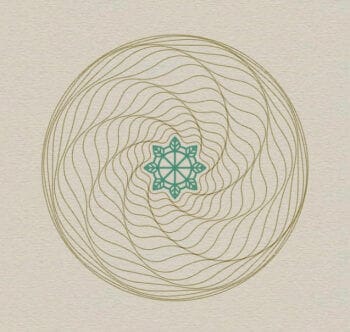
With the basic concept pretty clear in my own mind I was able to put together an estimate with 4 wall mounted options; as a flat piece or a dish and both of these variants in either bronze resin or foundry bronze. This was accompanied with a simplified sketch of the ripples emerging from the waterwheel which would be made in 5mm laser cut metal. A few weeks later I was informed that that they were happy to move forward with the wall mounted piece in bronze resin and in a dish form.
First site visit
I was invited for a site visit and whilst the majority of the development itself had already been completed, the garden was very much a building site. Over the next few weeks the plans started to emerge as to how the garden would look and it quickly became apparent that the piece would be positioned in the centre of the garden rather than mounted on a wall. The client provided me with a render of how the garden would look and I decided that working with a pale minimalist stone for a pedestal would be in keeping with the overall feel of the garden and not draw attention away from the sculpture itself.
Finalising the drawings and costs
When metal ages, a patina forms on the surface and this seemed like the perfect way to tie in the old with the new. I settled on creating the centrepiece in copper, which when it oxidises creates a beautiful pale green patina (Verdigris) which would clearly also work well with the garden theme. With the piece now being viewed in its entirety from all angles, I suggested that the Verdigris patina would also work well on the back of the bronze dish, thus giving the piece a different personality from the rippled front face. I adjusted the back of the dish by adding a “buttress” which would allow thick stainless steel rods to be housed on the inside of the piece and be embedded into the stone. It would also create a larger surface area to bond to the stone thus making the piece extremely secure.
The pedestal would be concreted into a foundation and the final few centimetres of the cavity would be filled with a decorative pea gravel. The additional costs of a sandstone pedestal, inlaying a stainless steel plaque and the more challenging job of safely and securely locating a 400kg piece of sandstone into position were approved and now with a clear idea of the project I worked on finalising the concept with a 3D computer render.
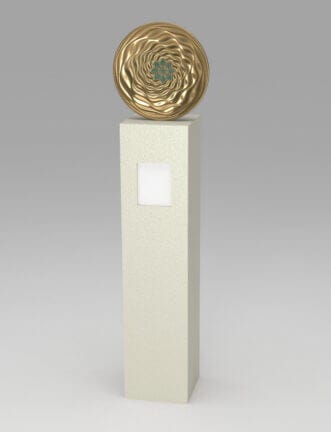

Creating the piece
With the green light to commence the making process, I starting working on creating the master copy, making a mould from this and then the process of casting the final sculpture in bronze resin. I drilled the holes for the metal rods, polished the bronze surface to a brushed finish and created a Verdigris patina for both the copper logo and the back section of the dish. The copper logo was then glued in place and the whole piece was finished with a metal lacquer to protect it from the elements.
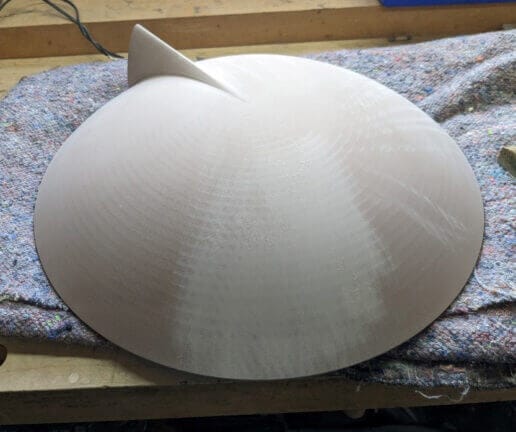

Selecting the stone
The stonemason supplied me with two sandstone samples and the choice of the Ramsbottom sandstone was based not only on its pale colour but the fact that it has subtle figuring. This helped to highlight the fact that it was a natural product rather than other more characterless stones which could easily be mistaken for coloured cast concrete. In addition, with the stone being from a quarry less than 15 miles from site this would also be in keeping with the emphasis on sourcing locally.
However it was also important to stress to the stone masons that the veins in the stone should marry well with the vertical orientation of the pedestal itself as well as not being too distracting from the artwork itself. Whilst the block of stone would be cut when I wasn’t present, the director totally understood my brief and left me feeling reassured that they would select a suitable slab to cut the piece from. I left the finished sculpture with them so that they could perfectly match the location holes in the buttress with the corresponding holes to be drilled in the top of the stone.
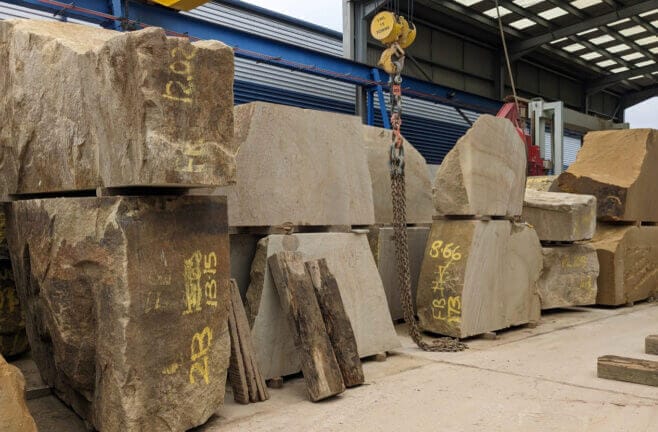
Installation and unveiling
The client arranged an appropriate size foundation to be dug and a week later I returned to the site to oversee the sandstone being concreted in and the sculpture bonded to the base with the stainless rods in place. The following day, once the concrete was set, I finished it off with pale, peach coloured pea gravel.
Finally in early September of 2023, the sculpture was unveiled by local MP Christian Wakeford. As a proud Mancunian it seemed like the perfect project for my first piece of public Art. An added bonus was that my family could be present for the occasion.
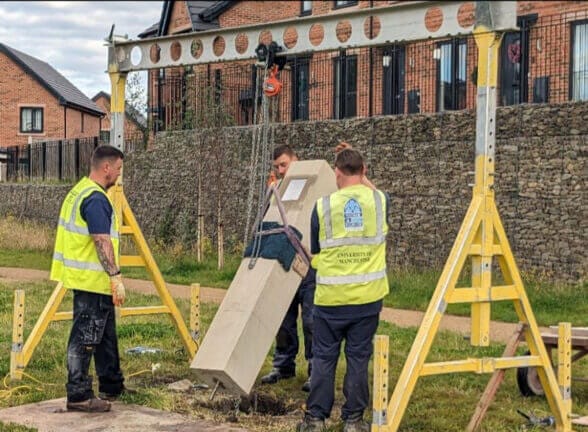

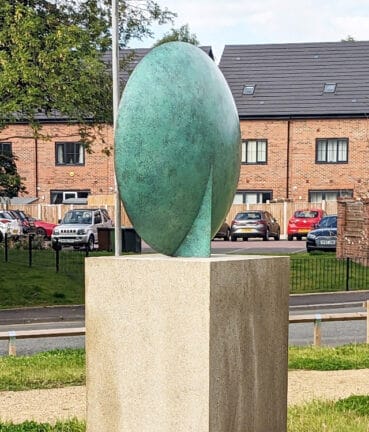
Conclusion
There isn’t a fixed way as to how the process of commissioning happens. It will sometimes depend on how clear the client’s original ideas are as well as whether the site / room etc is planned and ready or still under development. In this case, the design fee was embedded within the original estimate as the client would have a pretty clear idea of the end product from the offset. I made suggestions as to what I felt would be the best solutions for a durable, exterior project and with options to choose from let the client make the final decisions. They were kept informed as to any changes in costing as the brief changed and then billed accordingly.
Testimonials
The pieces arrived yesterday and look spectacular. I sent pictures to my sister who responded by writing “Works of Art. Thank youJon Landau, Wellington, New Zealand
Reflecting his creativity and attention to fine detail, Corona embodied the blend of wonderful natural material and highly skilled craftsmanship that we were looking for. Now in situ, Corona looks absolutely stunning and is a real talking point for guests as well as providing pleasure to us on a daily basis. We would highly recommend David to anyone seeking something similarly beautiful for their homePaul and Karen Dickinson, Cheshire, UK
We so enjoyed the process from beginning to end. It was a journey that encompassed and introduced us to your world. A world of creativity, passion and perfection. Such a privilege to be able to enjoy your stunning creations in our home.Joanne and Russel, Middlesex, UK
Your work is impeccable.Inas, Surrey, UK
I commissioned David to create one of his stunning sculptural side tables for my husband’s 50th birthday and he didn’t disappoint. I felt part of every step of the process, from the arrival of the wood, through to each phase of creation to deliver a superb piece of craftsmanship. My husband was absolutely thrilled and it takes pride of place in our sitting room.Sally-Anne, Cheshire, UK
The way you shared the design and creation of Genie with me was wonderful. I am touched by your Art and the way you convey it. I wish you a lot of success!Nathalie, Paris, France
As an interior designer it is always exciting to discover new talent. David is not only a dedicated and talented furniture maker and designer but has the additional qualities of being a lovely person to work with, personally and professionally. He has produced some beautiful work for some very important clients of mine who have been delighted with the quality and attention to detail that David brings to his work.Jan Williamson, Cheshire, UK
Just a quick note to let you know that I have spent most of the afternoon tripping in and out to look at “that beautiful table”. It is just what I wanted; something very distinctive that kick-starts the future look for the room. It was so good to see your work at Tatton and now to have a beautiful piece of my own, which is the central inspiration for what will be a great room.Charlotte and Clive Makin, Warrington, UK
I commissioned David to make a small hall table a short time ago. It was based on an idea which I had in my mind for a long time. As an architect I have a particular interest in workmanship, materials and design. David’s work excelled everything I had expected and the final finish is exemplary and does not seem to be showing any signs of wear even though it has been rather abused.Michael Cummings, Manchester, UK
David is a unique craftsman, incredibly passionate about his design and prides himself on involving his customers throughout the process.Alli Campbell, Manchester, UK